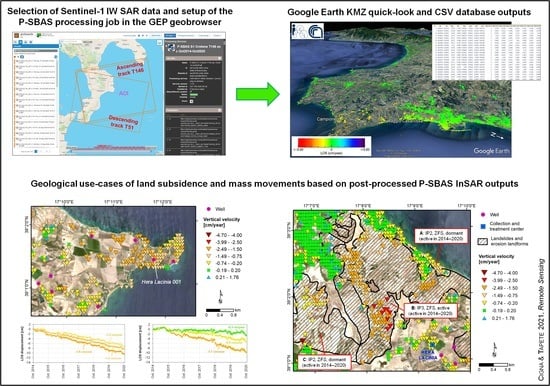Sentinel-1 Big Data Processing with P-SBAS InSAR in the Geohazards Exploitation Platform: An Experiment on Coastal Land Subsidence and Landslides in Italy
Abstract
1. Introduction
- First, to demonstrate that through parallelized InSAR processing chains running on data exploitation platforms, it is possible to process big SAR time series made of an unprecedented number of Sentinel-1 images, i.e., in the order of hundreds per single observation geometry.
- Second, to showcase that big InSAR datasets can be generated across geographic areas of either urban or rural land cover (or a mixture of them), and later be post-processed to derive value-added products. These InSAR datasets are as “big” in the time-domain as the amount of input SAR images, and therefore as the number of observations composing the deformation time series of each persistent or coherent target obtained at the end of the multi-interferogram processing. Furthermore, they are “big” in the space-domain on the basis of the total number of persistent or coherent targets themselves that the interferogram network created during InSAR processing has allowed to identify over the long time span investigated (despite the relatively small region of interest of this work).
- Third, to prove that such big InSAR datasets can be handled through post-processing and data integration methodologies that have been established by the geohazard community in the last decade, and be transformed into higher-level geospatial information to characterize geological hazards of potential concern of local stakeholders. Without claiming to fully develop specific user-oriented or user-driven applications, this paper does not restrict to the presentation of InSAR results only (which is the dominant feature of most of the published literature on InSAR processing using cloud/grid computing), but also encompasses selected use-cases of geological interpretation.
2. Study Area
3. Materials and Methods
3.1. Input SAR Data
3.2. P-SBAS InSAR Processing
3.3. Vertical and East-West Deformation Field Estimation
3.4. Deformation along the Steepest Slope Direction
4. Results
5. Discussion
5.1. Geological Interpretation
5.1.1. Coastal Land Subsidence at the Capo Colonna Promontory
5.1.2. Landslides and Erosion Landforms
5.1.3. Ground Deformation in the City of Crotone
5.2. Potential and Challenges of Big Data
6. Conclusions
Author Contributions
Funding
Institutional Review Board Statement
Informed Consent Statement
Data Availability Statement
Acknowledgments
Conflicts of Interest
References
- Gabriel, A.K.; Goldstein, R.M.; Zebker, H.A. Mapping small elevation changes over large areas: Differential radar interferometry. J. Geophys. Res. 1989, 94, 9183–9191. [Google Scholar] [CrossRef]
- Massonnet, D.; Feigl, K.L. Radar interferometry and its application to changes in the earth’s surface. Rev. Geophys. 1998, 36, 441–500. [Google Scholar] [CrossRef]
- Rosen, P.A.; Hensley, S.; Joughin, I.R.; Li, F.K.; Madsen, S.N.; Rodriguez, E.; Goldstein, R.M. Synthetic aperture radar interferometry. Proc. IEEE 2000, 88, 333–380. [Google Scholar] [CrossRef]
- Ferretti, A.; Prati, C.; Rocca, F. Permanent scatterers in SAR interferometry. IEEE Trans. Geosci. Remote Sens. 2001, 39, 8–20. [Google Scholar] [CrossRef]
- Crosetto, M.; Monserrat, O.; Cuevas-González, M.; Devanthéry, N.; Crippa, B. Persistent Scatterer Interferometry: A review. ISPRS J. Photogramm. Remote Sens. 2016, 115, 78–89. [Google Scholar] [CrossRef]
- Berardino, P.; Fornaro, G.; Lanari, R.; Sansosti, E. A new algorithm for surface deformation monitoring based on small baseline differential SAR interferograms. IEEE Trans. Geosci. Remote Sens. 2002, 40, 2375–2383. [Google Scholar] [CrossRef]
- Lanari, R.; Mora, O.; Manunta, M.; Mallorquí, J.J.; Berardino, P.; Sansosti, E. A small-baseline approach for investigating deformations on full-resolution differential SAR interferograms. IEEE Trans. Geosci. Remote Sens. 2004, 42, 1377–1386. [Google Scholar] [CrossRef]
- Virelli, M.; Coletta, A.; Battagliere, M.L. ASI COSMO-SkyMed: Mission Overview and Data Exploitation. IEEE Geosci. Remote Sens. Mag. 2014, 2, 64–66. [Google Scholar] [CrossRef]
- ESA Sentinel-1 Observation Scenario. Available online: https://sentinel.esa.int/web/sentinel/missions/sentinel-1/observation-scenario (accessed on 26 March 2020).
- Gomes, V.C.F.; Queiroz, G.R.; Ferreira, K.R. An overview of platforms for big Earth observation data management and analysis. Remote Sens. 2020, 12, 1253. [Google Scholar] [CrossRef]
- Sudmanns, M.; Tiede, D.; Lang, S.; Bergstedt, H.; Trost, G.; Augustin, H.; Baraldi, A.; Blaschke, T. Big Earth data: Disruptive changes in Earth observation data management and analysis? Int. J. Digit. Earth 2020, 13, 832–850. [Google Scholar] [CrossRef]
- ESA Copernicus Open Access Hub. Available online: https://scihub.copernicus.eu/dhus (accessed on 1 November 2020).
- Zinno, I.; Casu, F.; De Luca, C.; Elefante, S.; Lanari, R.; Manunta, M. A Cloud Computing Solution for the Efficient Implementation of the P-SBAS DInSAR Approach. IEEE J. Sel. Top. Appl. Earth Obs. Remote Sens. 2017, 10, 802–817. [Google Scholar] [CrossRef]
- Loibl, D.; Bookhagen, B.; Valade, S.; Schneider, C. OSARIS, the “open source SAR investigation system” for automatized parallel insar processing of Sentinel-1 time series data with special emphasis on cryosphere applications. Front. Earth Sci. 2019, 7, 172. [Google Scholar] [CrossRef]
- Cigna, F.; Tapete, D.; Casagli, N. Semi-automated extraction of Deviation Indexes (DI) from satellite Persistent Scatterers time series: Tests on sedimentary volcanism and tectonically-induced motions. Nonlinear Process. Geophys. 2012, 19, 643–655. [Google Scholar] [CrossRef]
- Berti, M.; Corsini, A.; Franceschini, S.; Iannacone, J.P. Automated classification of Persistent Scatterers Interferometry time series. Nat. Hazards Earth Syst. Sci. 2013, 13, 1945–1958. [Google Scholar] [CrossRef]
- Notti, D.; Calò, F.; Cigna, F.; Manunta, M.; Herrera, G.; Berti, M.; Meisina, C.; Tapete, D.; Zucca, F. A User-Oriented Methodology for DInSAR Time Series Analysis and Interpretation: Landslides and Subsidence Case Studies. Pure Appl. Geophys. 2015, 172, 3081–3105. [Google Scholar] [CrossRef]
- Chang, L.; Hanssen, R.F. A Probabilistic Approach for InSAR Time-Series Postprocessing. IEEE Trans. Geosci. Remote Sens. 2016, 54, 421–430. [Google Scholar] [CrossRef]
- Casu, F.; Elefante, S.; Imperatore, P.; Zinno, I.; Manunta, M.; De Luca, C.; Lanari, R. SBAS-DInSAR Parallel Processing for Deformation Time-Series Computation. IEEE J. Sel. Top. Appl. Earth Obs. Remote Sens. 2014, 7, 3285–3296. [Google Scholar] [CrossRef]
- Foumelis, M.; Papadopoulou, T.; Bally, P.; Pacini, F.; Provost, F.; Patruno, J. Monitoring Geohazards Using On-Demand and Systematic Services on ESA’s Geohazards Exploitation Platform. In Proceedings of the International Geoscience and Remote Sensing Symposium (IGARSS), Yokohama, Japan, 28 July–2 August 2019; IEEE: Yokohama, Japan, 2019; pp. 5457–5460. [Google Scholar]
- Committee on Earth Observation Satellites (CEOS). CEOS WG Disasters: Working Group on Disasters. Available online: http://ceos.org/ourwork/workinggroups/disasters/ (accessed on 3 November 2020).
- Lanari, R.; Bonano, M.; Casu, F.; De Luca, C.; Manunta, M.; Manzo, M.; Onorato, G.; Zinno, I. Automatic Generation of Sentinel-1 Continental Scale DInSAR Deformation Time Series through an Extended P-SBAS Processing Pipeline in a Cloud Computing Environment. Remote Sens. 2020, 12, 2961. [Google Scholar] [CrossRef]
- Burnol, A.; Foumelis, M.; Gourdier, S.; Deparis, J.; Raucoules, D. Tracking and measuring of clay shrinking and swelling using spaceborne remote sensing. EarthArxiv 2020. [Google Scholar] [CrossRef]
- Cigna, F.; Tapete, D. Present-day land subsidence rates, surface faulting hazard and risk in Mexico City with 2014–2020 Sentinel-1 IW InSAR. Remote Sens. Environ. 2021, 253, 1–19. [Google Scholar] [CrossRef]
- Bakon, M.; Czikhardt, R.; Papco, J.; Barlak, J.; Rovnak, M.; Adamisin, P.; Perissin, D. remotIO: A Sentinel-1 Multi-Temporal InSAR Infrastructure Monitoring Service with Automatic Updates and Data Mining Capabilities. Remote Sens. 2020, 12, 1892. [Google Scholar] [CrossRef]
- Guerricchio, A. Tectonics, Deep Seated Gravitational Slope Deformations (DSGSDs) and Large Landslides in the Calabrian Region (Southern Italy). G. Geol. Appl. 2005, 1, 73–90. [Google Scholar] [CrossRef]
- Stanley, J.D.; Bernasconi, M.P. Buried and submerged greek archaeological coastal structures and artifacts as gauges to measure late holocene seafloor subsidence off Calabria, Italy. Geoarchaeology 2012, 27, 189–205. [Google Scholar] [CrossRef]
- Zecchin, M.; Accaino, F.; Ceramicola, S.; Civile, D.; Critelli, S.; Da Lio, C.; Mangano, G.; Prosser, G.; Teatini, P.; Tosi, L. The Crotone Megalandslide, southern Italy: Architecture, timing and tectonic control. Sci. Rep. 2018, 8, 1–11. [Google Scholar] [CrossRef] [PubMed]
- Ministero dello Sviluppo Economico, MISE. MISE Ricerca e Coltivazione di Idrocarburi. Available online: https://unmig.mise.gov.it/index.php/it/dati/ricerca-e-coltivazione-di-idrocarburi (accessed on 30 September 2020).
- Zecchin, M.; Civile, D.; Caffau, M.; Sturiale, G.; Roda, C. Sequence stratigraphy in the context of rapid regional uplift and high-amplitude glacio-eustatic changes: The Pleistocene Cutro Terrace (Calabria, southern Italy). Sedimentology 2011, 58, 442–477. [Google Scholar] [CrossRef]
- Zecchin, M.; Civile, D.; Caffau, M.; Roda, C. Facies and cycle architecture of a Pleistocene marine terrace (Crotone, southern Italy): A sedimentary response to late Quaternary, high-frequency glacio-eustatic changes. Sediment. Geol. 2009, 216, 138–157. [Google Scholar] [CrossRef]
- Minelli, L.; Billi, A.; Faccenna, C.; Gervasi, A.; Guerra, I.; Orecchio, B.; Speranza, G. Discovery of a gliding salt-detached megaslide, Calabria, Ionian Sea, Italy. Geophys. Res. Lett. 2013, 40, 4220–4224. [Google Scholar] [CrossRef]
- Van Dijk, J.P. Late Neogene kinematics of intra-arc oblique shear zones: The Petilia-Rizzuto Fault Zone (Calabrian Arc, Central Mediterranean). Tectonics 1994, 13, 1201–1230. [Google Scholar] [CrossRef]
- Massari, F.; Prosser, G.; Capraro, L.; Fornaciari, E.; Consolaro, C. A revision of the stratigraphy and geology of the south-western part of the Crotone Basin (South Italy). Ital. J. Geosci. 2010, 129, 353–384. [Google Scholar] [CrossRef]
- Zecchin, M.; Nalin, R.; Roda, C. Raised Pleistocene marine terraces of the Crotone peninsula (Calabria, southern Italy): Facies analysis and organization of their deposits. Sediment. Geol. 2004, 172, 165–185. [Google Scholar] [CrossRef]
- Zecchin, M.; Caffau, M.; Civile, D.; Critelli, S.; Di Stefano, A.; Maniscalco, R.; Muto, F.; Sturiale, G.; Roda, C. The Plio-Pleistocene evolution of the Crotone Basin (southern Italy): Interplay between sedimentation, tectonics and eustasy in the frame of Calabrian Arc migration. Earth-Sci. Rev. 2012, 115, 273–303. [Google Scholar] [CrossRef]
- Verdecchia, F.; Zoccatelli, C.; Norelli, E.; Miandro, R. Integrated monitoring network for surface deformation in Capo Colonna archaeological area, Crotone, Italy. IAHS-AISH Publ. 2010, 339, 345–351. [Google Scholar]
- Basili, R.; Barba, S.; Burrato, P.; Fracassi, U.; Kastelic, V.; Tiberti, M.M.; Vannoli, P.; Stramondo, S.; Tolomei, C.; Soligo, M.; et al. Project S1: Analysis of the Seismic Potential in Italy for the Evaluation of the Seismic Hazard. Deliverable # 3.01.1 Technical Report Illustrating the Results Obtained in the Crotone Peninsula Based on Geological and InSAR Data; INGV: Rome, Italy, 2010. [Google Scholar]
- Tapete, D.; Cigna, F. Site-specific analysis of deformation patterns on archaeological heritage by satellite radar interferometry. Mater. Res. Soc. Symp. Proc. 2012, 1374, 283–295. [Google Scholar] [CrossRef]
- Zecchin, M. Relationships between fault-controlled subsidence and preservation of shallow-marine small-scale cycles: Example from the lower Pliocene of the Crotone Basin (southern Italy). J. Sediment. Res. 2005, 75, 300–312. [Google Scholar] [CrossRef]
- Lena, G.; Bonomi, S. Erosione costiera e monumenti archeologici in Calabria. Geol. dell’Ambient. 2012, 1, 8–13. [Google Scholar]
- Martinelli, G.; Cremonini, S.; Samonati, E. Geological and Geochemical Setting of Natural Hydrocarbon Emissions in Italy. In Advances in Natural Gas Technology; InTech: Vienna, Austria, 2012. [Google Scholar]
- Cazzini, F.F. The History of the Upstream Oil and Gas Industry in Italy; Geological Society of London, Geological Society Special Publication: London, UK, 2018; Volume 465, pp. 243–274. [Google Scholar]
- Dacome, M.C.; Miandro, R.; Vettorel, M.; Roncari, G. Subsidence monitoring network: An Italian example aimed at a sustainable hydrocarbon E&P activity. Proc. Int. Assoc. Hydrol. Sci. 2015, 372, 379–384. [Google Scholar]
- Confuorto, P.; Plank, S.; Novellino, A.; Tessitore, S.; Ramondini, M. Implementation of DInSAR methods for the monitoring of the archaeological site of Hera Lacinia in Crotone (Southern Italy). Rend. Online Soc. Geol. Ital. 2016, 41, 231–234. [Google Scholar] [CrossRef]
- Cigna, F.; Confuorto, P.; Novellino, A.; Tapete, D.; Di Martire, D.; Ramondini, M.; Calcaterra, D.; Plank, S.; Ietto, F.; Brigante, A.; et al. 25 years of satellite InSAR monitoring of ground instability and coastal geohazards in the archaeological site of Capo Colonna, Italy. In SAR Image Analysis, Modeling, and Techniques XVI; SPIE: Edinburgh, UK, 2016; Volume 10003, p. 100030Q. [Google Scholar]
- Tapete, D.; Cigna, F. COSMO-SkyMed SAR for detection and monitoring of archaeological and cultural heritage sites. Remote Sens. 2019, 11, 1326. [Google Scholar] [CrossRef]
- Confuorto, P. From Site-Scale to Large Areas Monitoring of Ground Deformation Phenomena by Integration of Different DInSAR Techniques in Crotone Province (Southern Italy); University of Naples Federico II: Naples, Italy, 2016. [Google Scholar]
- Luca, F.; Robustelli, G.; Conforti, M.; Fabbricatore, D. Geomorphological map of the Crotone Province (Calabria, South Italy). J. Maps 2011, 7, 375–390. [Google Scholar] [CrossRef][Green Version]
- Torres, R.; Snoeij, P.; Geudtner, D.; Bibby, D.; Davidson, M.; Attema, E.; Potin, P.; Rommen, B.Ö.; Floury, N.; Brown, M.; et al. GMES Sentinel-1 mission. Remote Sens. Environ. 2012, 120, 9–24. [Google Scholar] [CrossRef]
- De Zan, F.; Monti Guarnieri, A. TOPSAR: Terrain Observation by Progressive Scans. IEEE Trans. Geosci. Remote Sens. 2006, 44, 2352–2360. [Google Scholar] [CrossRef]
- Shamshiri, R.; Nahavandchi, H.; Motagh, M. Persistent Scatterer Analysis Using Dual-Polarization Sentinel-1 Data: Contribution from VH Channel. IEEE J. Sel. Top. Appl. Earth Obs. Remote Sens. 2018, 11, 3105–3112. [Google Scholar] [CrossRef]
- Azadnejad, S.; Maghsoudi, Y.; Perissin, D. Investigating the effect of the physical scattering mechanism of the dual-polarization Sentinel-1 data on the temporal coherence optimization results. Int. J. Remote Sens. 2019, 40, 7033–7047. [Google Scholar] [CrossRef]
- Manunta, M.; De Luca, C.; Zinno, I.; Casu, F.; Manzo, M.; Bonano, M.; Fusco, A.; Pepe, A.; Onorato, G.; Berardino, P.; et al. The Parallel SBAS Approach for Sentinel-1 Interferometric Wide Swath Deformation Time-Series Generation: Algorithm Description and Products Quality Assessment. IEEE Trans. Geosci. Remote Sens. 2019, 57, 6259–6281. [Google Scholar] [CrossRef]
- De Luca, C.; Cuccu, R.; Elefante, S.; Zinno, I.; Manunta, M.; Casola, V.; Rivolta, G.; Lanari, R.; Casu, F. An On-Demand Web Tool for the Unsupervised Retrieval of Earth’s Surface Deformation from SAR Data: The P-SBAS Service within the ESA G-POD Environment. Remote Sens. 2015, 7, 15630–15650. [Google Scholar] [CrossRef]
- Zinno, I.; Elefante, S.; Mossucca, L.; De Luca, C.; Manunta, M.; Terzo, O.; Lanari, R.; Casu, F. A First Assessment of the P-SBAS DInSAR Algorithm Performances Within a Cloud Computing Environment. IEEE J. Sel. Top. Appl. Earth Obs. Remote Sens. 2015, 8, 4675–4686. [Google Scholar] [CrossRef]
- Zinno, I.; Mossucca, L.; Elefante, S.; De Luca, C.; Casola, V.; Terzo, O.; Casu, F.; Lanari, R. Cloud computing for earth surface deformation analysis via spaceborne radar imaging: A case study. IEEE Trans. Cloud Comput. 2016, 4, 104–118. [Google Scholar] [CrossRef]
- De Luca, C.; Zinno, I.; Manunta, M.; Lanari, R.; Casu, F. Large areas surface deformation analysis through a cloud computing P-SBAS approach for massive processing of DInSAR time series. Remote Sens. Environ. 2017, 202, 3–17. [Google Scholar] [CrossRef]
- Zinno, I.; Bonano, M.; Buonanno, S.; Casu, F.; De Luca, C.; Manunta, M.; Manzo, M.; Lanari, R. National Scale Surface Deformation Time Series Generation through Advanced DInSAR Processing of Sentinel-1 Data within a Cloud Computing Environment. IEEE Trans. Big Data 2018, 6, 558–571. [Google Scholar] [CrossRef]
- Barone, A.; Fedi, M.; Tizzani, P.; Castaldo, R. Multiscale Analysis of DInSAR Measurements for Multi-Source Investigation at Uturuncu Volcano (Bolivia). Remote Sens. 2019, 11, 703. [Google Scholar] [CrossRef]
- Cigna, F.; Tapete, D. Satellite InSAR survey of structurally-controlled land subsidence due to groundwater exploitation in the Aguascalientes Valley, Mexico. Remote Sens. Environ. 2021, 254, 1–23. [Google Scholar] [CrossRef]
- Albano, M.; Polcari, M.; Bignami, C.; Moro, M.; Saroli, M.; Stramondo, S. An innovative procedure for monitoring the change in soil seismic response by InSAR data: Application to the Mexico City subsidence. Int. J. Appl. Earth Obs. Geoinf. 2016, 53, 146–158. [Google Scholar] [CrossRef]
- Ikuemonisan, F.E.; Ozebo, V.C.; Olatinsu, O.B. Geostatistical evaluation of spatial variability of land subsidence rates in Lagos, Nigeria. Geod. Geodyn. 2020, 11, 316–327. [Google Scholar] [CrossRef]
- Ikuemonisan, F.E.; Ozebo, V.C. Characterisation and mapping of land subsidence based on geodetic observations in Lagos, Nigeria. Geod. Geodyn. 2020, 11, 151–162. [Google Scholar] [CrossRef]
- Cigna, F.; Tapete, D.; Garduño-Monroy, V.H.; Muñiz-Jauregui, J.A.; García-Hernández, O.H.; Jiménez-Haro, A. Wide-area InSAR survey of surface deformation in urban areas and geothermal fields in the eastern Trans-Mexican Volcanic Belt, Mexico. Remote Sens. 2019, 11, 2341. [Google Scholar] [CrossRef]
- Figueroa-Miranda, S.; Hernández-Madrigal, V.M.; Tuxpan-Vargas, J.; Villaseñor-Reyes, C.I. Evolution assessment of structurally-controlled differential subsidence using SBAS and PS interferometry in an emblematic case of central Mexico. Eng. Geol. 2020, 105860. [Google Scholar] [CrossRef]
- Bacques, G.; de Michele, M.; Foumelis, M.; Raucoules, D.; Lemoine, A.; Briole, P. Sentinel optical and SAR data highlights multi-segment faulting during the 2018 Palu-Sulawesi earthquake (Mw 7.5). Sci. Rep. 2020, 10, 1–11. [Google Scholar] [CrossRef] [PubMed]
- Galve, J.P.; Pérez-Peña, J.V.; Azañón, J.M.; Closson, D.; Caló, F.; Reyes-Carmona, C.; Jabaloy, A.; Ruano, P.; Mateos, R.M.; Notti, D.; et al. Evaluation of the SBAS InSAR service of the European space Agency’s Geohazard Exploitation Platform (GEP). Remote Sens. 2017, 9, 1291. [Google Scholar] [CrossRef]
- Castaldo, R.; Barone, A.; Fedi, M.; Tizzani, P. Multiridge Method for Studying Ground-Deformation Sources: Application to Volcanic Environments. Sci. Rep. 2018, 8, 1–15. [Google Scholar] [CrossRef]
- Pepe, S.; D’Auria, L.; Castaldo, R.; Casu, F.; De Luca, C.; De Novellis, V.; Sansosti, E.; Solaro, G.; Tizzani, P. The use of massive deformation datasets for the analysis of spatial and temporal evolution of Mauna Loa Volcano (Hawai’i). Remote Sens. 2018, 10, 968. [Google Scholar] [CrossRef]
- De Novellis, V.; Castaldo, R.; De Luca, C.; Pepe, S.; Zinno, I.; Casu, F.; Lanari, R.; Solaro, G. Source modelling of the 2015 Wolf volcano (Galápagos) eruption inferred from Sentinel 1-A DInSAR deformation maps and pre-eruptive ENVISAT time series. J. Volcanol. Geotherm. Res. 2017, 344, 246–256. [Google Scholar] [CrossRef]
- Cignetti, M.; Manconi, A.; Manunta, M.; Giordan, D.; De Luca, C.; Allasia, P.; Ardizzone, F. Taking advantage of the ESA G-POD service to study ground deformation processes in high mountain areas: A Valle d’Aosta case study, Northern Italy. Remote Sens. 2016, 8, 852. [Google Scholar] [CrossRef]
- Yague-Martinez, N.; De Zan, F.; Prats-Iraola, P. Coregistration of Interferometric Stacks of Sentinel-1 TOPS Data. IEEE Geosci. Remote Sens. Lett. 2017, 14, 1002–1006. [Google Scholar] [CrossRef]
- Zebker, H.A.; Villasenor, J. Decorrelation in interferometric radar echoes. IEEE Trans. Geosci. Remote Sens. 1992, 30, 950–959. [Google Scholar] [CrossRef]
- Goldstein, R.M.; Werner, C.L. Radar interferogram filtering for geophysical applications. Geophys. Res. Lett. 1998, 25, 4035–4038. [Google Scholar] [CrossRef]
- Yang, Y.; Pepe, A.; Manzo, M.; Bonano, M.; Liang, D.N.; Lanari, R. A simple solution to mitigate noise effects in time-redundant sequences of small baseline multi-look DInSAR interferograms. Remote Sens. Lett. 2013, 4, 609–618. [Google Scholar] [CrossRef]
- Pepe, A.; Yang, Y.; Manzo, M.; Lanari, R. Improved EMCF-SBAS processing chain based on advanced techniques for the noise-filtering and selection of small baseline multi-look DInSAR interferograms. IEEE Trans. Geosci. Remote Sens. 2015, 53, 4394–4417. [Google Scholar] [CrossRef]
- Pepe, A.; Calò, F. A review of interferometric synthetic aperture RADAR (InSAR) multi-track approaches for the retrieval of Earth’s Surface displacements. Appl. Sci. 2017, 7, 1264. [Google Scholar] [CrossRef]
- Aslan, G.; Cakir, Z.; Lasserre, C.; Renard, F. Investigating subsidence in the Bursa Plain, Turkey, using ascending and descending Sentinel-1 satellite data. Remote Sens. 2019, 11, 85. [Google Scholar] [CrossRef]
- Murgia, F.; Bignami, C.; Brunori, C.A.; Tolomei, C.; Pizzimenti, L. Ground deformations controlled by hidden faults: Multi-frequency and multitemporal insar techniques for urban hazard monitoring. Remote Sens. 2019, 11, 2246. [Google Scholar] [CrossRef]
- Fuhrmann, T.; Garthwaite, M.C. Resolving three-dimensional surface motion with InSAR: Constraints from multi-geometry data fusion. Remote Sens. 2019, 11, 241. [Google Scholar] [CrossRef]
- Pepe, A.; Solaro, G.; Calò, F.; Dema, C. A Minimum Acceleration Approach for the Retrieval of Multiplatform InSAR Deformation Time Series. IEEE J. Sel. Top. Appl. Earth Obs. Remote Sens. 2016, 9, 3883–3898. [Google Scholar] [CrossRef]
- Cascini, L.; Fornaro, G.; Peduto, D. Advanced low- and full-resolution DInSAR map generation for slow-moving landslide analysis at different scales. Eng. Geol. 2010, 112, 29–42. [Google Scholar] [CrossRef]
- Cigna, F.; Bianchini, S.; Casagli, N. How to assess landslide activity and intensity with Persistent Scatterer Interferometry (PSI): The PSI-based matrix approach. Landslides 2013, 10, 267–283. [Google Scholar] [CrossRef]
- Coastal Zones—Copernicus Land Monitoring Service. Available online: https://land.copernicus.eu/local/coastal-zones (accessed on 22 November 2020).
- Autorità di Bacino della Regione Calabria—PAI 2016. Available online: http://old.regione.calabria.it/abr/index.php?option=com_content&task=view&id=504&Itemid=1 (accessed on 3 November 2020).
- Bähr, H.; Hanssen, R.F. Reliable estimation of orbit errors in spaceborne SAR interferometry: The network approach. J. Geod. 2012, 86, 1147–1164. [Google Scholar] [CrossRef]
- Raspini, F.; Cigna, F.; Moretti, S. Multi-temporal mapping of land subsidence at basin scale exploiting persistent scatterer interferometry: Case study of Gioia Tauro plain (Italy). J. Maps 2012, 8, 514–524. [Google Scholar] [CrossRef]
- Sowter, A.; Bateson, L.; Strange, P.; Ambrose, K.; Fifiksyafiudin, M. DInSAR estimation of land motion using intermittent coherence with application to the South Derbyshire and Leicestershire coalfields. Remote Sens. Lett. 2013, 4, 979–987. [Google Scholar] [CrossRef]
- Cigna, F.; Sowter, A. The relationship between intermittent coherence and precision of ISBAS InSAR ground motion velocities: ERS-1/2 case studies in the UK. Remote Sens. Environ. 2017, 202, 177–198. [Google Scholar] [CrossRef]
- Bianchini, S.; Cigna, F.; Righini, G.; Proietti, C.; Casagli, N. Landslide HotSpot Mapping by means of Persistent Scatterer Interferometry. Environ. Earth Sci. 2012, 67, 1155–1172. [Google Scholar] [CrossRef]
- Cruden, D.M.; Varnes, D.J. Landslide types and processes. In Landslides: Investigation and Mitigation, Sp. Rep. 24; Turner, A.K., Schuster, R.L., Eds.; Transportation Research Board: Washington, DC, USA, 1996; pp. 36–75. [Google Scholar]
- Blewitt, G.; Hammond, W.; Kreemer, C. Harnessing the GPS Data Explosion for Interdisciplinary Science. Eos 2018, 99. [Google Scholar] [CrossRef]
- Lu, P.; Casagli, N.; Catani, F.; Tofani, V. Persistent scatterers interferometry hotspot and cluster analysis (PSI-HCA) for detection of extremely slow-moving landslides. Int. J. Remote Sens. 2012, 33, 466–489. [Google Scholar] [CrossRef]
- Tapete, D.; Casagli, N. Testing computational methods to identify deformation trends in RADARSAT persistent scatterers time series for structural assessment of archaeological heritage. In Lecture Notes in Computer Science; Springer: Berlin/Heidelberg, Germany, 2013; Volume 7972, pp. 693–707. [Google Scholar]
- Raspini, F.; Bianchini, S.; Ciampalini, A.; Del Soldato, M.; Solari, L.; Novali, F.; Del Conte, S.; Rucci, A.; Ferretti, A.; Casagli, N. Continuous, semi-automatic monitoring of ground deformation using Sentinel-1 satellites. Sci. Rep. 2018, 8, 1–11. [Google Scholar] [CrossRef] [PubMed]
- Ansari, H.; De Zan, F.; Bamler, R. Sequential Estimator: Toward Efficient InSAR Time Series Analysis. IEEE Trans. Geosci. Remote Sens. 2017, 55, 5637–5652. [Google Scholar] [CrossRef]
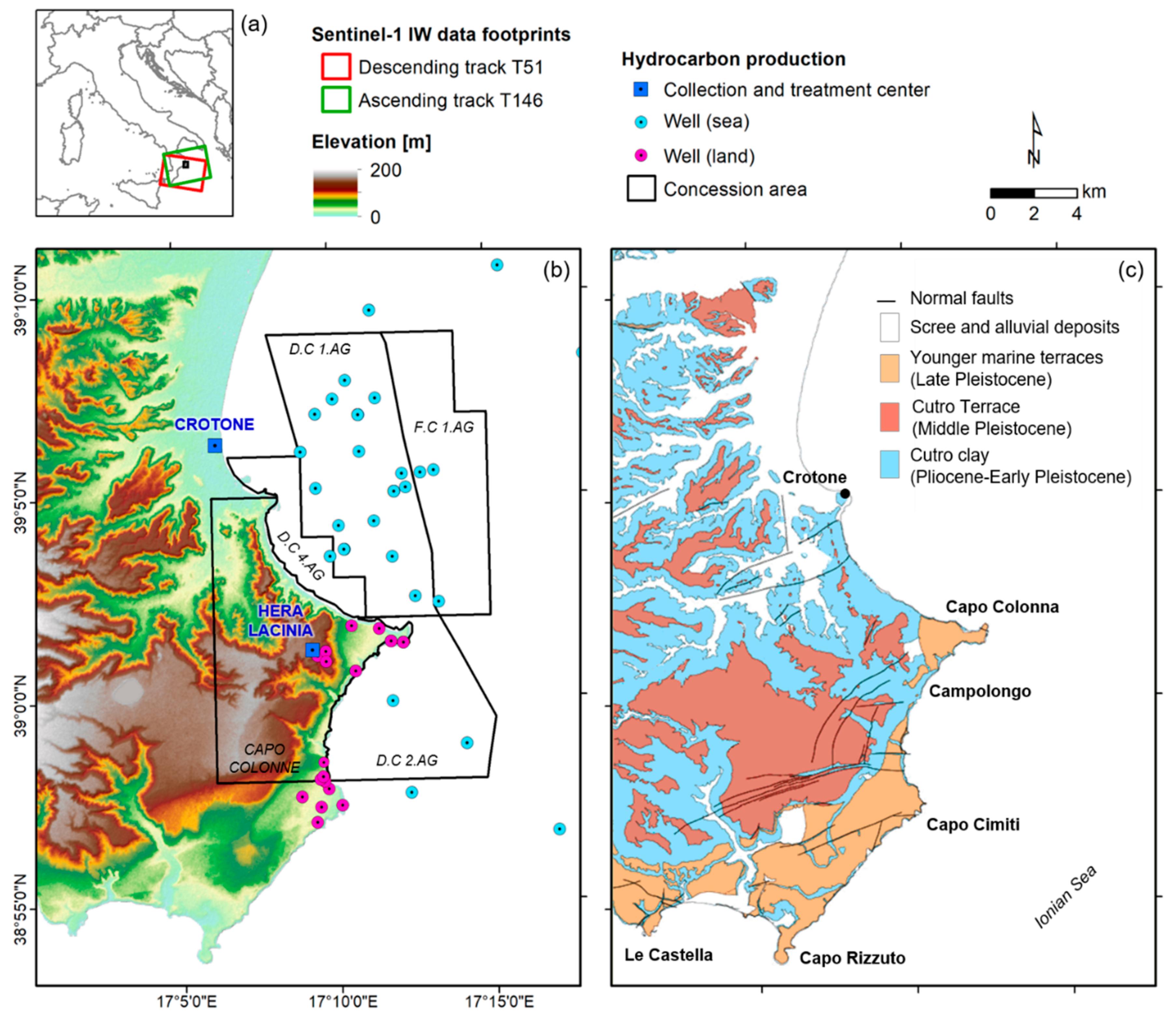
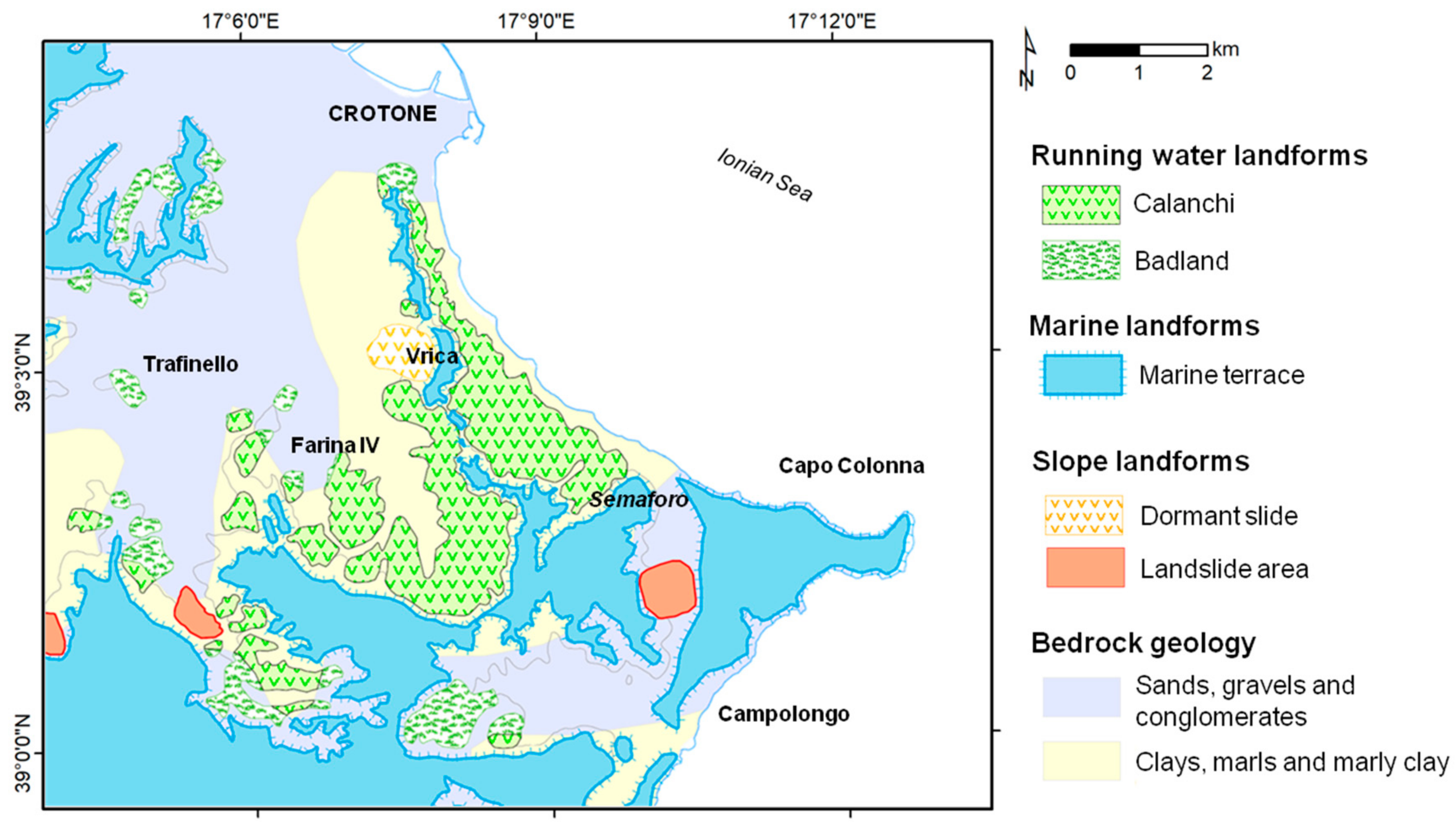
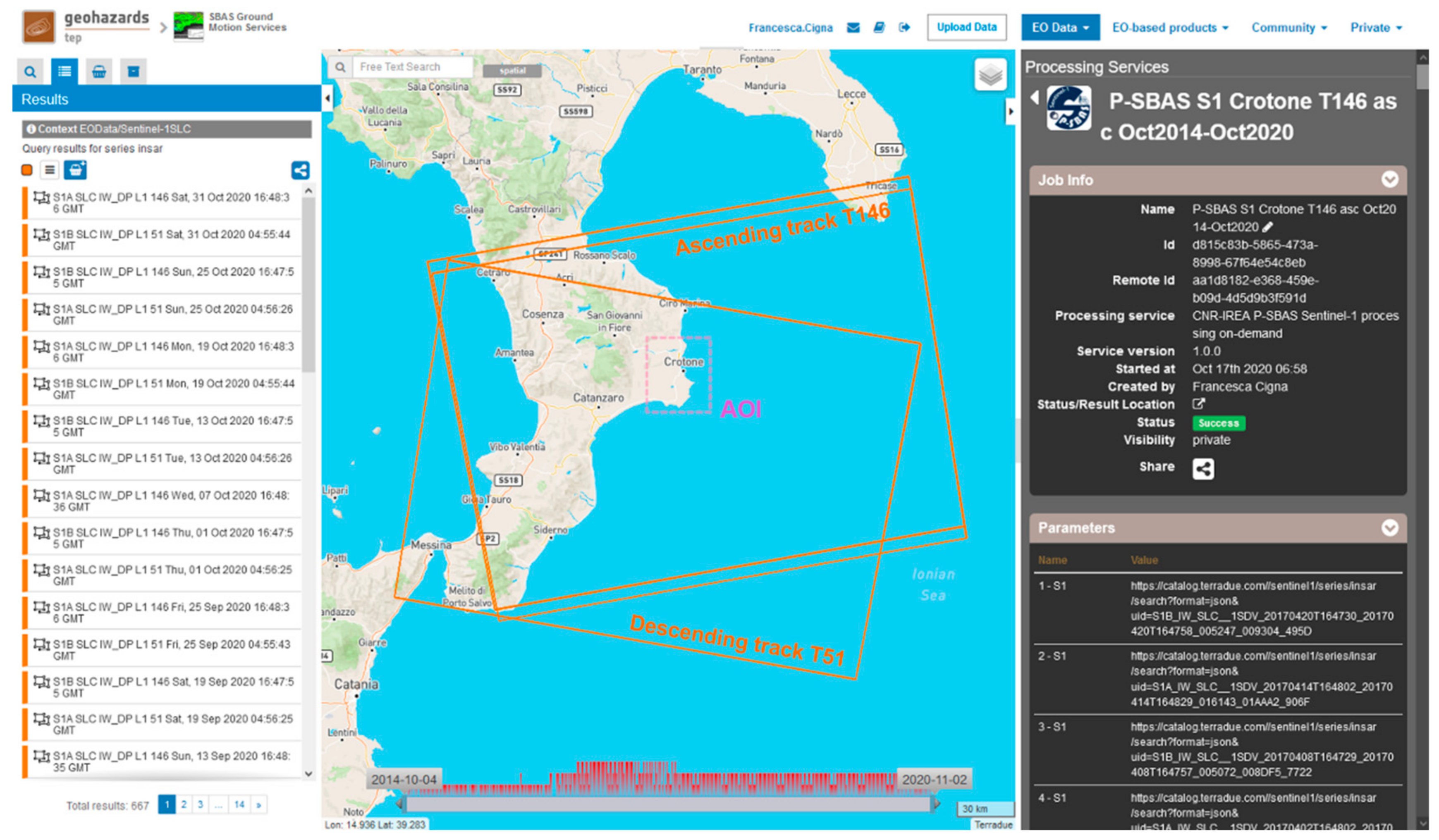
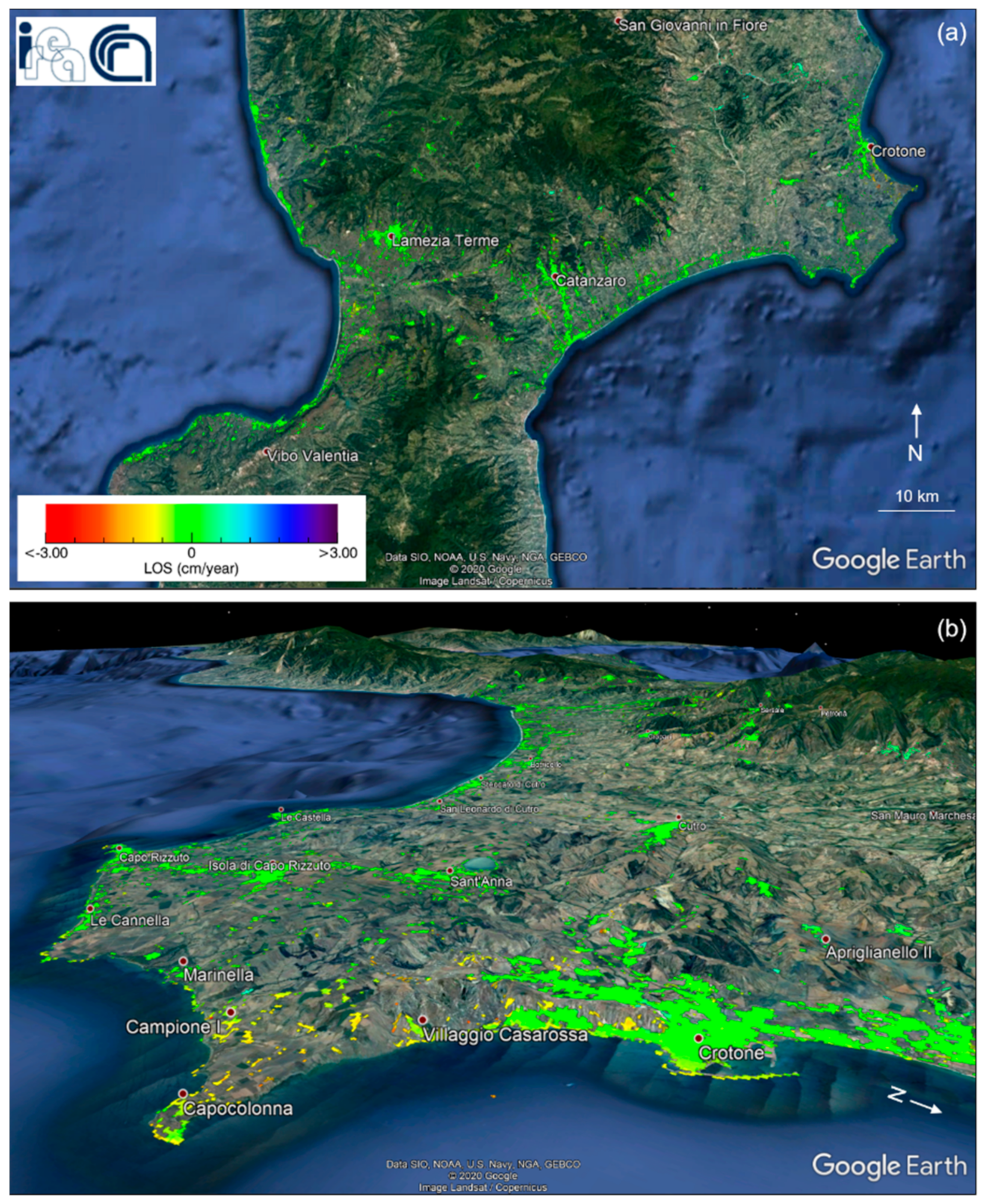


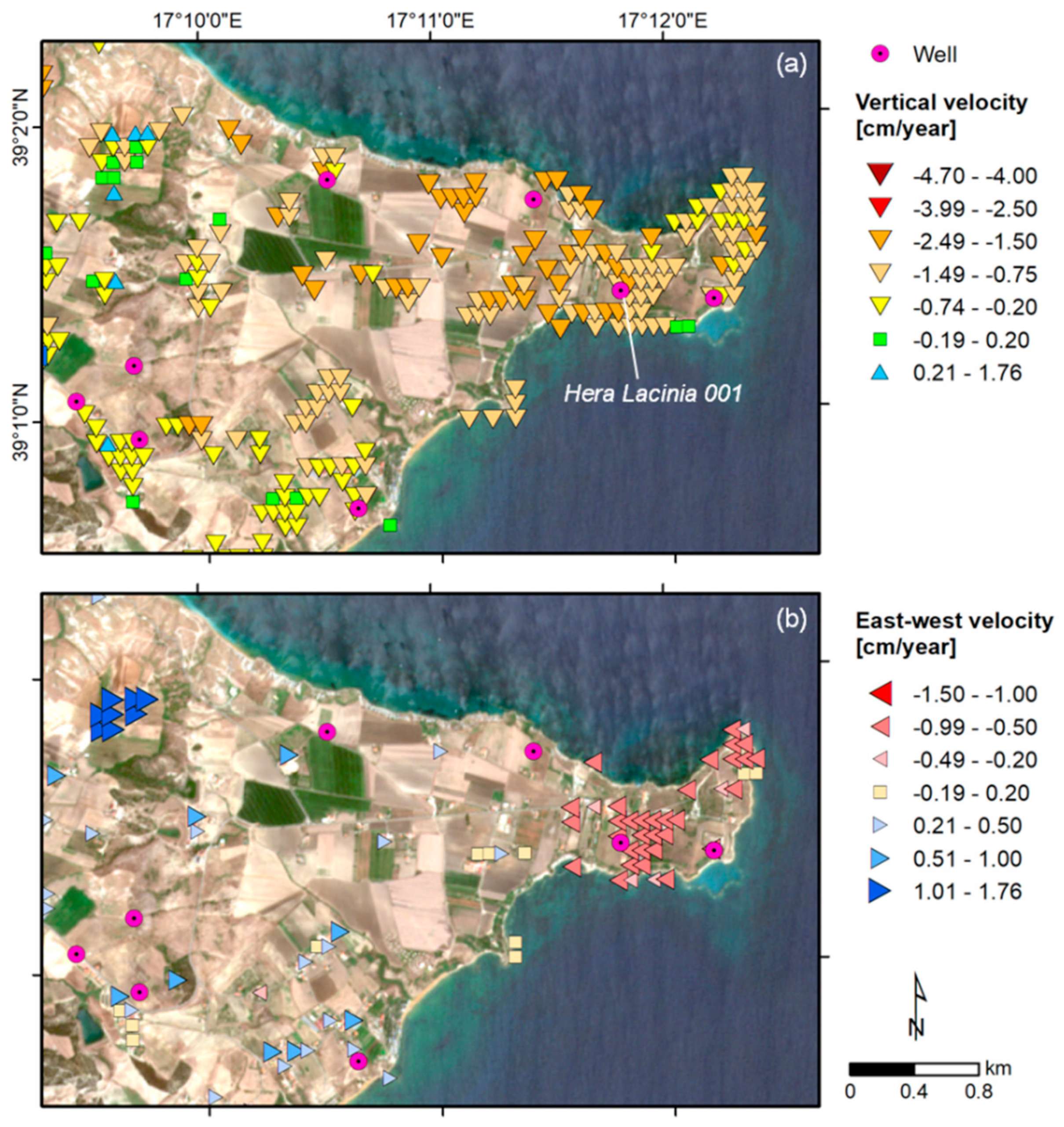
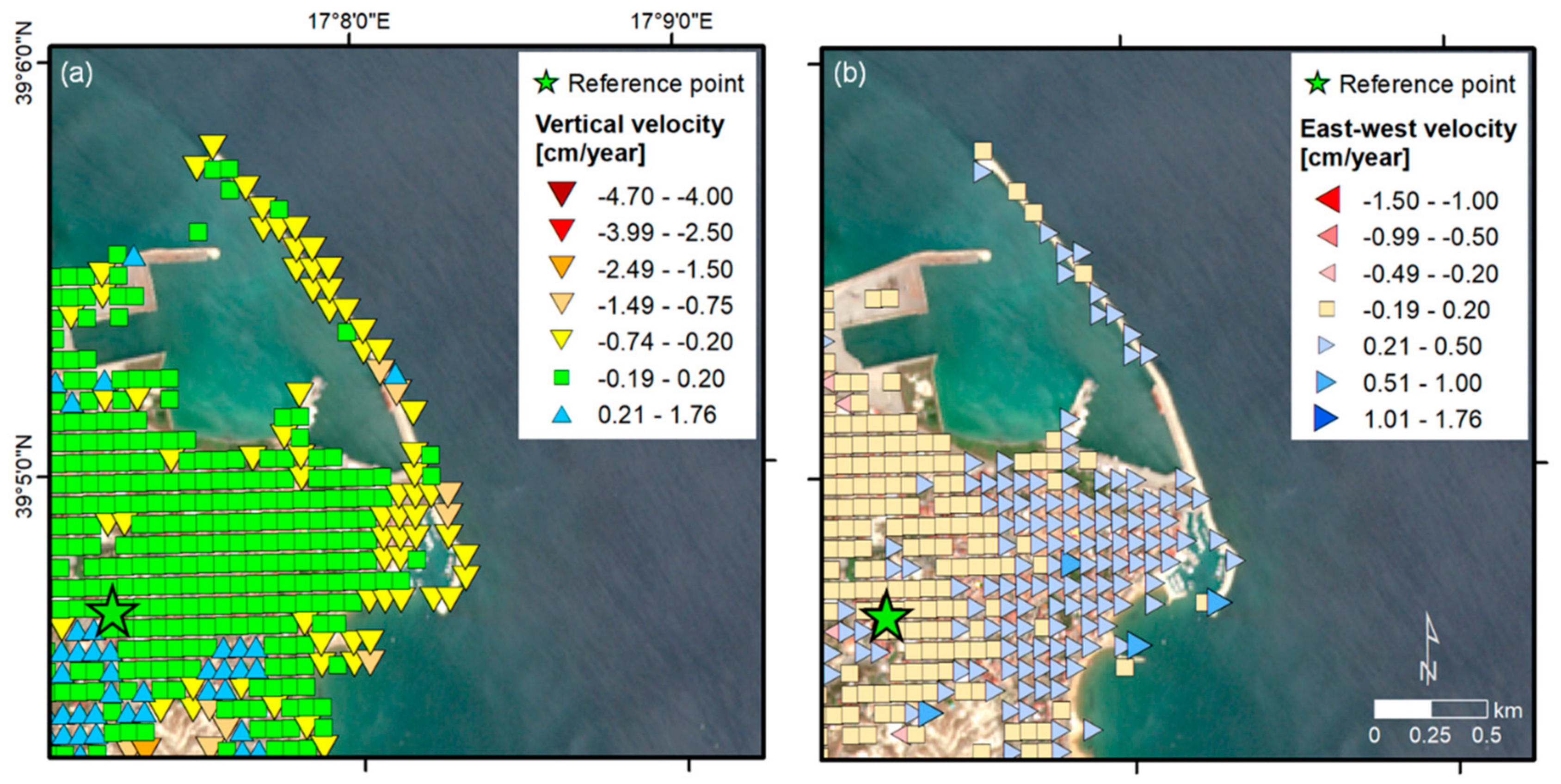
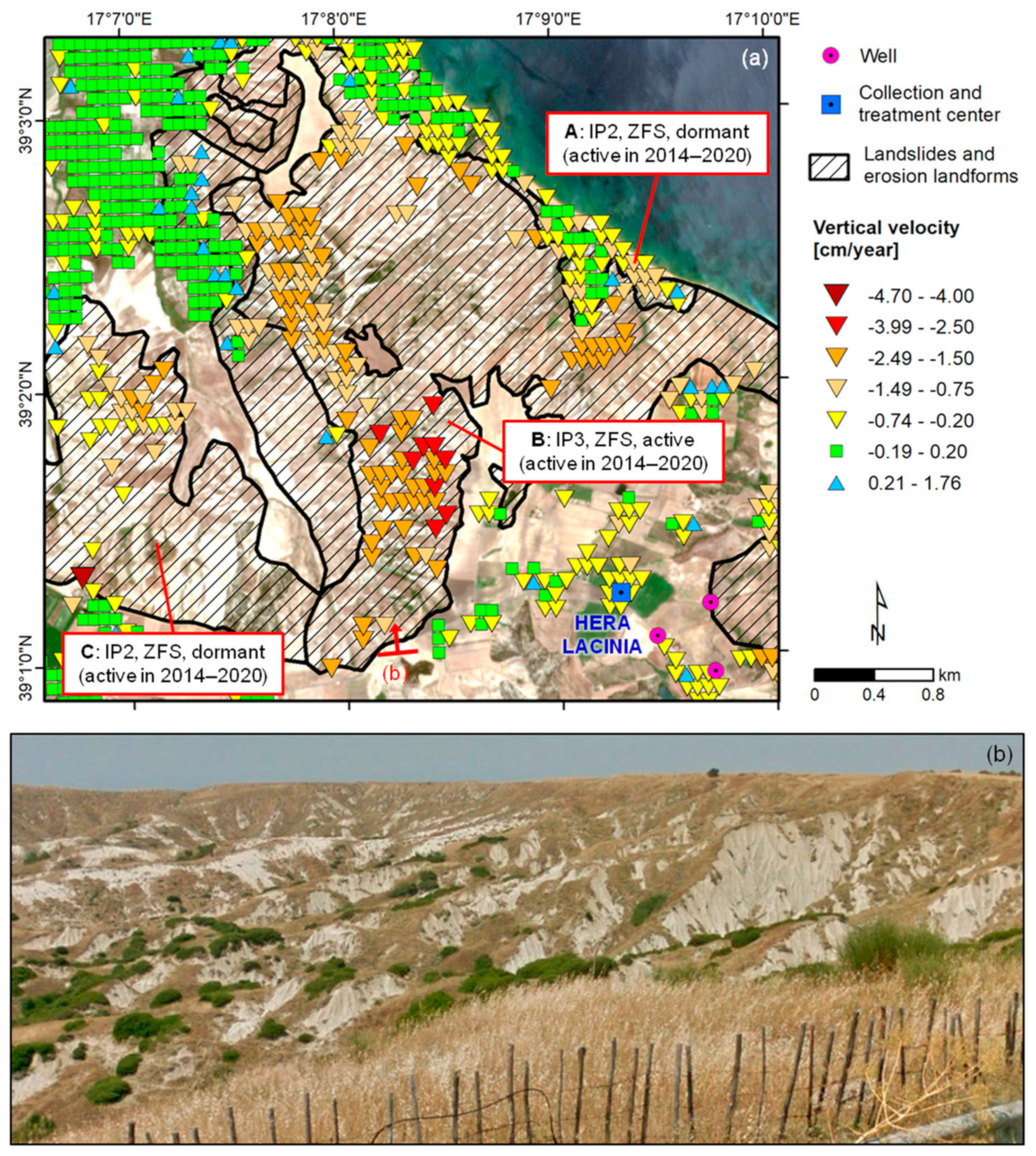
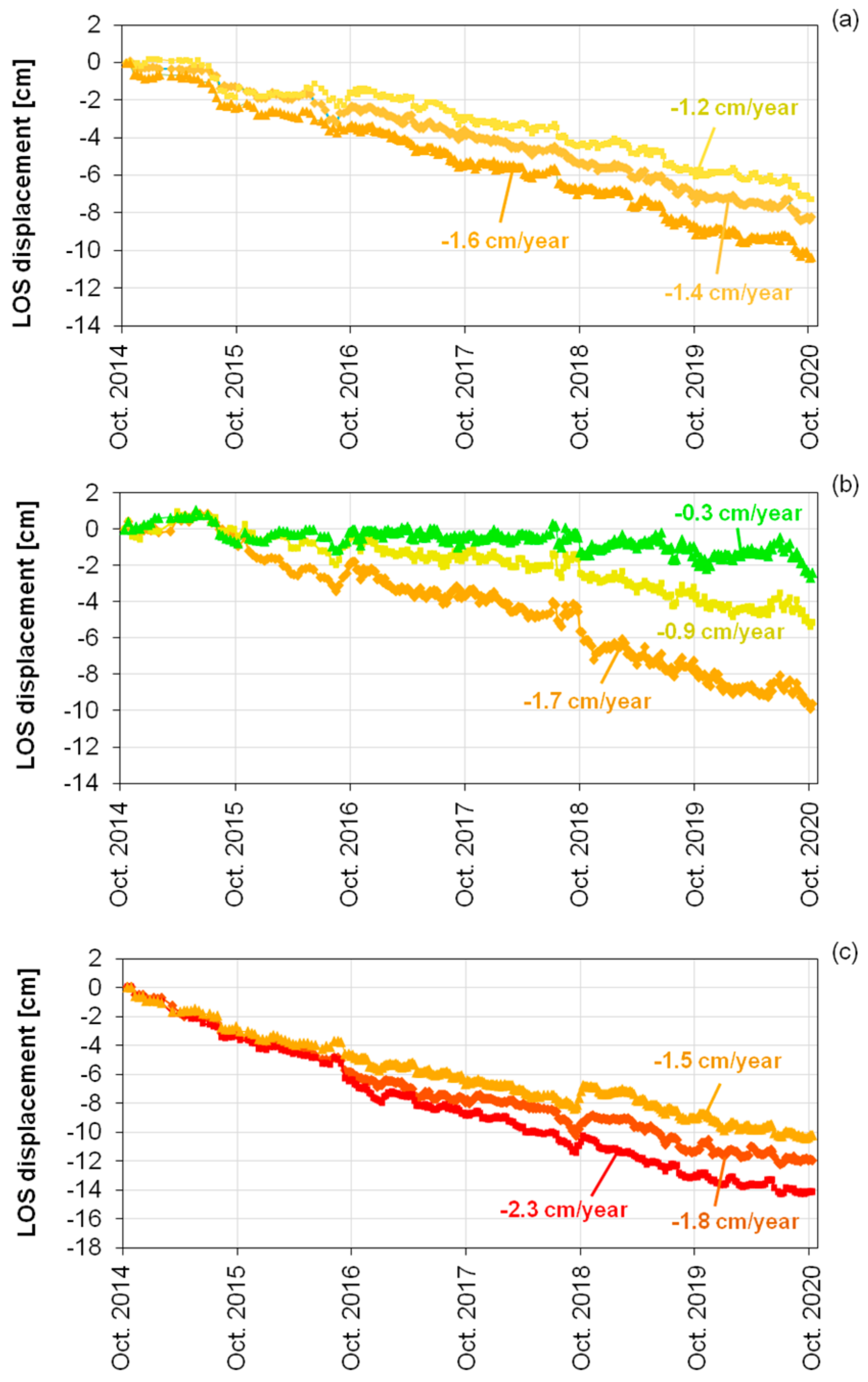

| Reference | Satellite Data | Period | Observed Deformation Rates |
|---|---|---|---|
| Basili et al. 2010 [38] | ERS-1/2 asc. ENVISAT asc. | 1995–2000 2002–2009 | More than −0.5 cm/year LOS rate |
| Tapete and Cigna 2012 [39] | ERS-1/2 asc./desc. ENVISAT asc. | 1992–2000 2003–2010 | Up to −1.0 (1992–2000) and −1.3 (2003–2010) cm/year LOS rate |
| Confuorto et al. 2016 [45] | TerraSAR-X asc./desc. | 2008–2010 | Up to −1.5 cm/year LOS rate, and −1.6 cm/year vertical rate |
| Cigna et al. 2016 [46] | ERS-1/2 asc./desc. (from [39]) ENVISAT asc. (from [39]) TerraSAR-X asc./desc. (from [45]) COSMO-SkyMed asc./desc. Sentinel-1A asc. | 1992–2000 2003–2010 2008–2010 2011–2015 2014–2016 | Up to −2.0 (2011–2014), −1.0 (2014–2015) and −0.8 (2014–2016) cm/year LOS rate; up to −20 cm vertical displacement (1992–2016; stitched time series) |
| Zecchin et al. 2018 [28] | COSMO-SkyMed asc./desc. | 2011–2014 | Up to −0.5 cm/year east–west rate |
| Cigna and Tapete 2020 1 | Sentinel-1A/B asc./desc. | 2014–2020 | Up to −2.3 cm/year vertical and −1.0 cm/year east–west rate |
Publisher’s Note: MDPI stays neutral with regard to jurisdictional claims in published maps and institutional affiliations. |
© 2021 by the authors. Licensee MDPI, Basel, Switzerland. This article is an open access article distributed under the terms and conditions of the Creative Commons Attribution (CC BY) license (http://creativecommons.org/licenses/by/4.0/).
Share and Cite
Cigna, F.; Tapete, D. Sentinel-1 Big Data Processing with P-SBAS InSAR in the Geohazards Exploitation Platform: An Experiment on Coastal Land Subsidence and Landslides in Italy. Remote Sens. 2021, 13, 885. https://doi.org/10.3390/rs13050885
Cigna F, Tapete D. Sentinel-1 Big Data Processing with P-SBAS InSAR in the Geohazards Exploitation Platform: An Experiment on Coastal Land Subsidence and Landslides in Italy. Remote Sensing. 2021; 13(5):885. https://doi.org/10.3390/rs13050885
Chicago/Turabian StyleCigna, Francesca, and Deodato Tapete. 2021. "Sentinel-1 Big Data Processing with P-SBAS InSAR in the Geohazards Exploitation Platform: An Experiment on Coastal Land Subsidence and Landslides in Italy" Remote Sensing 13, no. 5: 885. https://doi.org/10.3390/rs13050885
APA StyleCigna, F., & Tapete, D. (2021). Sentinel-1 Big Data Processing with P-SBAS InSAR in the Geohazards Exploitation Platform: An Experiment on Coastal Land Subsidence and Landslides in Italy. Remote Sensing, 13(5), 885. https://doi.org/10.3390/rs13050885






